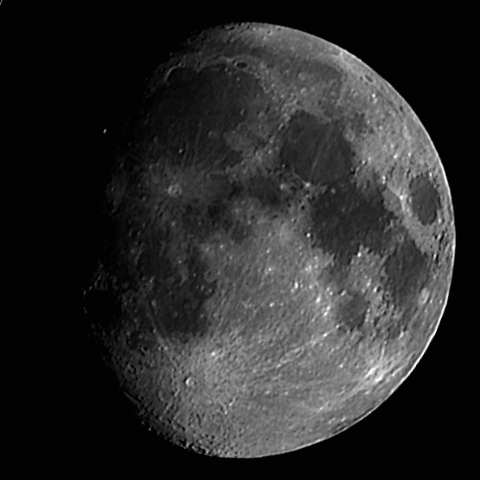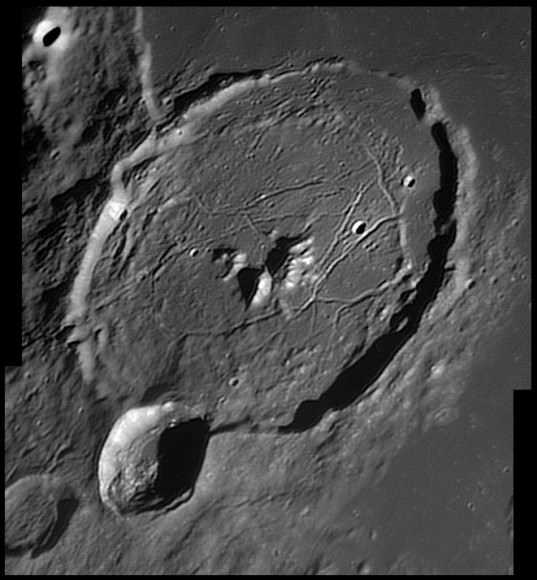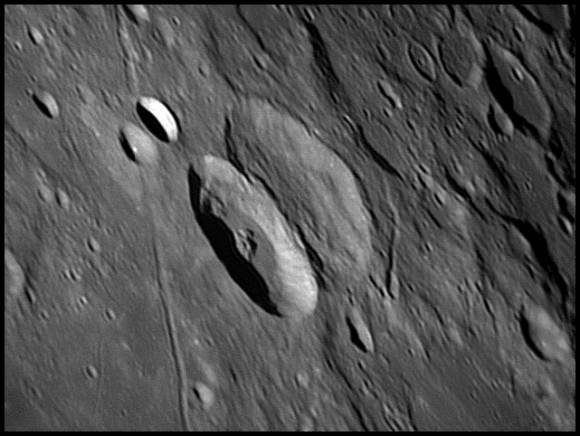Greetings, fellow SkyWatchers!
I’m sure everyone has been enjoying following the morning planet show, but are you ready for something else? If you’ve got a telescope, then we’ve got some projects for you. While it’s definitely going to be a “moon light” weekend, that doesn’t mean that you can’t have fun! Let’s take a look at what the night has to offer…
On Friday and Saturday evening, the most prominent lunar feature will be the ancient and graceful Gassendi. Its bright ring stands on the north shore of Mare Humorum – an area about the size of the state of Arkansas. Around 113 km in diameter and 2012 meters deep, you will see a triple mountain peak in its center and the south wall eroded by lava flows. Gassendi offers a wealth of details to telescopic observers on its ridge and rille covered floor.
When you have finished with your lunar observations, let’s travel on to a fascinating double star. A little less than a handspan south of the last star in the handle of the “Big Dipper”, you will see a fairly bright star that is on the edge of unaided eye detection thanks to tonight’s gibbous Moon. Aim your telescopes or steady binoculars there for a real treat! Alpha Canum is more commonly known as Cor Caroli – or the “heart of Charles” – and is a true jewel easily split by the most modest of instruments. Although some observers may not be able to distinguish a color difference between the magnitude 2.8 and 5.6 companions, it has been my experience that most will see a faded blue primary (a magnetic spectrum variable) and pale orange secondary on this 120 light year distant pair. If you are equatorially aligned, turn off the drive and wait for 150 seconds. Widely separated Struve 1702 will be coming into view…
On Sunday night your lunar challenge will be a challenging one – worthy of the larger scope. Start by identifying past study craters, Hansteen and Billy. Due west of Hansteen you will find a small crater near the terminator known as Sirsalis. It will appear as a small, dark ellipse with a bright west wall with its twin, Sirsalis B on the edge. The feature you will be looking for is the Sirsalis Rille – the longest presently known. Stretching northeast of Sirsalis and extending for 459 kilometers south to the bright rays of Byrgius, this major “crack” in the lunar surface will show several branches – like a long dry river bed.
Tonight let’s go from one navigational extreme to another as viewers in the northern hemisphere try their hand at Polaris. As guide star for north, Polaris is also a wonderful double with an easily resolved, faint blue companion for the mid-sized telescope. But what about the south? Viewers in the southern hemisphere can never see Polaris – is there a matching star for the south? The answer is yes – Sigma Octantis – but at magnitude 5, it doesn’t make a very good unaided eye guide. Ancient navigators found better success with the constellation of Crux, better known as the “Southern Cross”. While Crux has many wonderful double stars, if southern hemispere viewers would like to see a star very similar to Polaris, then try your luck with Lambda Centauris. The magnitude difference between components and separation are about the same.
Good luck and clear skies!
Many thanks to Peter Lloyd for setting the Moon phase stage and Damien Peach for his incredible lunar photos!




I plan on observing the moon this weekend with my 12×36 Image stabilized binoculars from a lawn chair – quick and easy! =-)
“if southern hemispere viewers would like to see a star very similar to Polaris,…”
My question would be why? Polaris only claim is the northern pole star. Who darn well cares in the southern hemisphere!.
– Also it is Lambda Centauri NOT Lambda Centauris.
– It is no a yellow cepheid, but is a blue B9III star (Alpha UMi is F7:IbIIv).
As for the curseth moon…. enough said! 🙁
He’s back!
Yes, it is the infamous HSBC. The response claiming the perceived Southern hemisphere slight confirms it.
Yes, it is the infamous HSBC. The response claiming the perceived Southern hemisphere slight confirms it.
G’day Tammy,
we have the best of the best so we can survive without Polaris heh heh.
clear skies mate
Stephen
Reading this, really makes me want to go out and have a look at the moon. I am going outside bump the moon and get some moon dust in my hair.
Great stuff. Always looking for more objects to observe, and love the challenging ones.